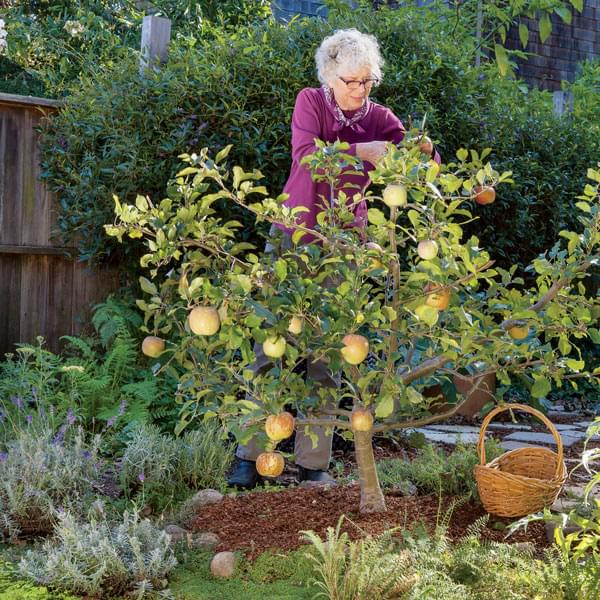Written by The Spruce and published on https://www.thespruce.com/.
The overall theory of pruning apple trees is to first train the young apple tree to grow efficiently, and then to promote the best production of good quality fruit as the tree matures. By training a young apple tree to grow “correctly” you enable the tree to develop a strong structure that will be able to support heavy apple growth, plus you will have a tree shape that is easy to manage in later years. A well-applied regimen of training and pruning apple trees stimulates the strong growth of only those branches you wish to keep as lasting parts of the mature tree.

Table of Contents
How to Prune an Overgrown Apple Tree
- Pruning an apple tree, much like pruning a peach tree, improves the tree’s vigor and fruit production. It seems complicated, and many gardeners are apprehensive about tackling the task. Take heart—it is almost impossible to kill a tree by pruning it, and most of the intimidating pruning takes place in the first three years of an apple tree’s life. After then, the hard part is over.
Pruning an apple tree should:
- Encourage fruiting spurs
- Open the branches so that sunlight and air can reach all the ripening fruit
Assemble your supplies:
- Pruning shears
- Lopping shears or saw for larger branches
- Ladder
- Heavy-duty gloves
- Protective gear: safety glasses, hardhat
- Debris barrel or sacks
Why You Need to Prune
Most fruit trees grown in home gardens are spurring types. A spur is a short (3- to 5-inch) branch where the apple tree flowers and sets fruit. Pruning encourages the tree to grow more of these fruiting spurs by removing competing suckers and unproductive wood.
Remove Any Wood That Is Unproductive and Attracts Problems
Start pruning by removing any dead, damaged, or diseased branches. The dead wood will be dark or brittle, often with the bark falling away. Diseased wood is usually a different color than the other branches. An open wound on a branch is an invitation to insects and further disease. You can, and should, prune dead and injured wood at any time of the year.
Prune and Remove Suckers From Branches
Plants are pruned to encourage more growth, but not all growth is welcome. Suckers (branches growing from the base of the tree), whorls (branches that grow from and encircle another branch), and water sprouts (thin branches that usually grow straight upright) are never going to bear fruit. They just sap energy from the plant. Removing them early in pruning will also help in seeing the structure of the tree, making it easier to see where further cuts are necessary.
Prune Low Branches
Get rid of any branches within about 4 feet of the ground. They’ll probably be too shaded to produce any apples, and they’ll just invite animals to nibble. Pruning these lower branches not only discourages pests but also improves air circulation around the base of the tree, reducing the risk of fungal infections. This practice can contribute to enhancing overall disease resistance in apple trees, ensuring healthier growth. Additionally, it allows the tree to focus its energy on producing fruit in the upper, sunlit branches, leading to a more abundant and quality harvest.
Pruning out Future Problems
Prune out any downward facing branches. They too will be shaded and won’t be productive. Next, focus on removing any branches that cross or rub against larger branches. As these grow, they will get thicker and heavier. Get rid of them now before they do damage to the branches needed in a scaffold.
Keeping Your Apple Tree Pruned to One Main Leader
Step back, and view the tree again. It should have one main leader or central trunk. The leader may be a bit curved because the tree wasn’t staked as it grew, or it could have been bent by the wind. That is OK, but the side branches on the leader will have to go. If they are left they will become competing branches and will distort the shape and openness of the tree. Prune them back.
Outward Facing Buds
When pruning out an entire branch, cutting back to the collar of the branch, slightly away from the trunk, is an option. Just follow the ring of the collar.
However, when only partially pruning the branch, try and prune to an outward-facing bud, which is one that is directed away from the neighboring branch. Cutting just above an outward-facing bud will encourage it to sprout a new branch that will grow out and away from the other existing branch. If a cut were made above an inward-facing bud, it would encourage a new branch that would cross and/or shade the existing inner branch, which would eventually have to be removed.
Clearing the Clutter
Now, focus on thinning interior branches, so that sunlight can reach all the fruits, and each branch will sit at a nice, strong angle of greater than 45 degrees from the leader. Be as ruthless as possible, without removing more than about one-third of the branches. Remove all spindly growth. Remember, all of this pruning is going to result in new growth, so the more eliminated now will be the less needed to deal with later.
Here’s What You’re Aiming for
Finally, make sure that upper branches are shorter than the lower branches. The final result should look like a pyramid with well-spaced horizontal branches. The old adage tells us a bird should be able to fly through the apple tree without its wings touching a branch.
It may look extreme when it’s finished, but the tree will bear healthier fruit and be easier to harvest as a result of these efforts.
Original post here https://www.thespruce.com/maintenance-pruning-an-overgrown-apple-tree-4070267.